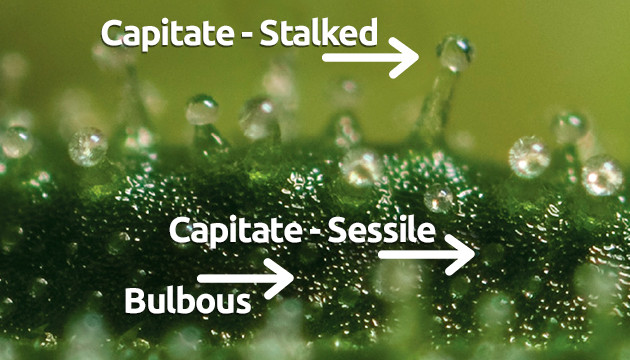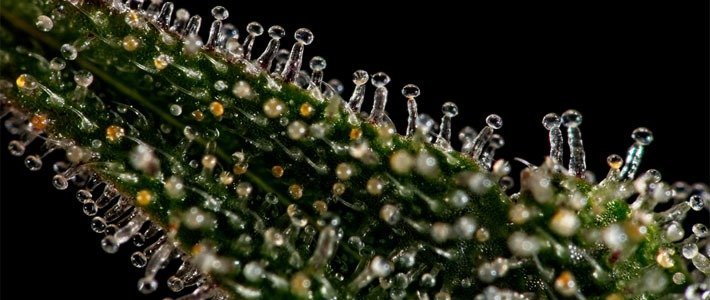Packed with cannabinoid-rich resin, these tiny, hair-like structures are where the magic happens, although the truth is that we still have a lot to learn about their function and morphology.
The Latest Research On Cannabis Trichomes
The fact that trichomes are the source of a cannabis plant’s cannabinoids, terpenes and flavonoids is not new knowledge, although it wasn’t until 2019 that scientists finally managed to track the life-cycle of these miniature structures.
The study, which appeared in The Plant Journal provided a detailed description of the three different types of trichome, known as bulbous, capitate sessile and capitate stalked trichomes.
Of these, capitate stalked trichomes are the largest, and therefore contain the most resin. Via a series of stunning photographs, the study authors revealed that most of the capitate sessile trichomes on a cannabis plant actually develop into the larger capitate stalked variety during flowering.
As a result, the proportion of stalked trichomes increases from 30 percent to 80 or 90 percent when a plant reaches maturity, allowing for a massive rise in cannabinoid synthesis. The three types of trichome: (L-R) Capitate stalked trichome, sessile and bulbous trichomes

The researchers also discovered that capitate sessile trichomes always contain exactly eight cells in their secretory disc, while capitate stalked trichomes can contain twice this number. Since it is these cells that release cannabinoids, terpenes and other useful compounds, it’s pretty clear to see why an increase in stalked trichomes is desirable.
Perhaps even more intriguingly, results also indicated that the trichomes that coat cannabis leaves have the same cannabinoid profile as those on the buds, yet tend to have a slightly different terpene profile. This suggests that leaf trichomes are just as potent as bud trichomes, but may have a different taste. Exactly why this is the case remains unexplained.
In a press release, study author Sam Livingstone revealed yet another trichomic mystery, explaining that “trichomes store the metabolites in their cell walls… And what’s really astounding is that such high levels of product should be toxic to the cells, so we want to understand how they manage this.”
Why Do Cannabis Plants Have Trichomes?
Many plants have trichomes, although their function differs greatly from species to species. Some carnivorous plants, for example, are coated in sticky trichomes that help to catch insects. The primary role of cannabis trichomes, however, is protection.
The cannabinoids, terpenes and flavonoids within these trichomes repel certain insects and other creatures that would otherwise munch their way through a plant’s leaves, while also attracting larger bugs that prey on these pests. It’s also thought that the cannabinoids act as a kind of sun block, protecting plants from harmful ultraviolet radiation.
As previously mentioned, the proportion of larger, capitate stalked trichomes increases sharply during flowering. Prior to this, plants are mostly covered in tiny bulbous trichomes, which are essentially just blobs made up of a handful of cells, and capitate sessile trichomes, which look like tiny hairs. Both of these are too small to see with the naked eye.
Capitate stalked trichomes consist of a stalk with a round head on top, and it is in this bulb that the resin is stored. These trichomes are just about visible to the naked eye, especially when they totally cover the surface of a plant – although they are best observed through a magnifying glass or a microscope.
How To Use Trichomes
Once your plants have matured, they should be coated in thousands upon thousands of capitate stalked trichomes, giving them a silvery sheen. If you’re planning on smoking your bud then you’ll need to handle them with extreme care during harvesting, as trichomes are easily damaged and readily fall off the plant to which they are attached.
They also degrade when exposed to heat, light or air, which is why it’s really important to dry and cure your weed properly. Doing so will massively increase its shelf life and ensure that the trichomes – and their precious contents – remain in good condition.
Alternatively, many growers choose to remove the trichomes in order to produce concentrates and extracts like hash, wax, cannabis oils or shatter. You’ll notice that these all sound like completely different products, although the truth is that they are all different forms of resin, which is essentially just trichomes that have been mushed together.
The means by which trichomes are extracted and fused tends to determine the nature of the concentrate that is produced. Manually sifting the dried trichomes, for instance, will leave you with a glittering pile of kief which can be sprinkled into joints or added to cannabutter when making edibles.
Kief can also be pressed to form hash, while hash oils are produced using hydrocarbon-based solvents like butane or propane in order to perform an extraction. Among the many benefits of cannabis concentrates is that they don’t degrade, and can therefore be stored indefinitely.
How To Read Your Trichomes
On top of everything else, trichomes also act as signposts that tell you exactly when your plants are ready to be harvested. The do this by changing colour, although you’ll need to look very closely in order to read them correctly. For this reason, many growers observe their trichomes using a type of magnifying glass called a jeweller’s loupe, as this allows for a more accurate observation than the naked eye.
As the cannabinoid concentration increases, terpenes turn from clear to cloudy, thereby indicating that a plant is ready to be harvested. If you wait a little longer, however, THC inside the terpenes will begin to be converted into cannabinol (CBN), causing them to turn amber.
Since CBN is associated with a strong couch-lock effect, many growers wait until about a quarter to a third of their trichomes have turned amber before harvesting. This ensures that their bud contains a decent mix of THC and CBN, providing a more rounded high with stronger body effects. Color and Using a Magnifying Glass is the “Ticket!”
How To Boost Trichome Numbers

The number of trichomes that cover a plant’s green surfaces will largely be determined by genetics, although environmental factors can also play a role. Since cannabis has evolved to develop trichomes as a form of protection from the sun’s rays, using a light source that contains the full colour spectrum is likely to result in a greater abundance of trichomes.
Modern LED arrays are therefore favoured by many growers, as these emit a more complete range of wavelengths than HPS lights.
It’s worth noting, however, that more trichomes won’t always increase the strength of your weed, and that many interlocking factors work together to determine a plant’s total cannabinoid yield.
Other things I do are:
- Add Probiotics & Sugar. The healthy bacteria in your yogurt can help produce more trichomes. These are lactobacillus bacteria strains.
- Shine More Light. The more hours of light, the more trichomes your girls will produce. …
- Carefully Stress Out Your Plants. If you stress out your plants, they’ll go into survival mode and produce more trichomes to protect themselves from adverse conditions.
- Light Dep. Light dep is short for light deprivation. Normally, it’s a technique that is used to trigger early flowering.
Kevin



0 Comments